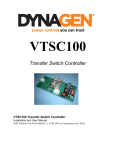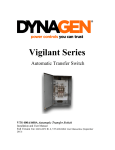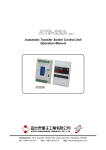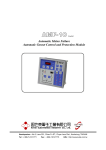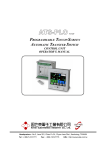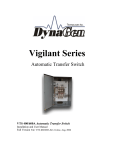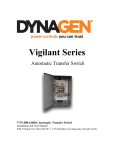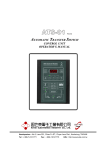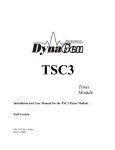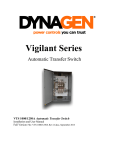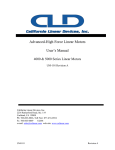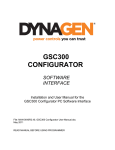Download VTSC100 User Manual R1.4
Transcript
VTSC100 Transfer Switch Controller VTSC100 Transfer Switch Controller Installation and User Manual Full Version File: MAN-0068 R1.4, VTSC100 User Manual.doc (September 2013) 2 Thank You for Purchasing This DynaGen Product Please Read Manual before Installing Unit Receipt of Shipment and Warranty Return Information Upon receipt of shipment, carefully remove the unit from the shipping container and thoroughly examine the unit for shipping damage. In case of damage, immediately contact the carrier and request that an inspection report be filed prior to contacting DynaGen. All returned items are to be shipped prepaid and include a Return Material Authorization (RMA) number issued by DynaGen. RMA forms are available by contacting DynaGen Technical Support through the contact methods listed below. Limited Warranty For warranty information refer to the standard terms and conditions of sale at http://www.dynagen.ca. Dynagen VTS Webpage For up-to-date manuals and other information please see the VTS section of the Dynagen website at: http://www.dynagen.ca/products/VTS.htm U U Operating & Installation Manual for the VTSC100 Transfer Switch Controller 3 Table of Contents INTRODUCTION 4 SPECIFICATIONS VTSC100 Identification Wiring Guidelines 12/24VDC Operation Terminal Description Outline Dimension Drawing 5 6 7 7 8 9 TIMER SETTINGS TDES TDNE TDEN TDEC TDNP – Delay on Neutral Test point measurements 120/277 System Voltage Setting 50/60 Hertz setting Load/No load Over/Under Voltage setting Over/Under Frequency setting 10 11 11 11 11 11 12 13 14 15 16 17 DIP SWITCH SETTING – MASTER CHART 18 MANUAL TEST CONFIGURATION 19 LED INDICATIONS 21 LOGIC SEQUENCE 22 Operating & Installation Manual for the VTSC100 Transfer Switch Controller 4 INTRODUCTION The VTSC100 Transfer Switch Controller provides all the necessary timing functions for the proper operation of DynaGen’s Vigilant Series Automatic Transfer Switch. The VTSC100, in conjunction with DynaGen’s Vigilant Series Transfer Switch, allows customer adjustability for specific transfer conditions. In addition to adjustability, specific transfer conditions are also represented by LED illumination from the external annunciation board. The VTSC100 allows customer adjustability of transfer conditions such as engine start delay, delay on neutral (available on 600A – 1250A), normal to emergency delay, emergency to normal delay, and engine cooldown. Simple potentiometer variations will determine the amount of time the VTSC100 will wait before activating specific outputs to control transfer switch conditions. Test points are provided on the VTSC100 for the accurate calibration of time delays. As the VTSC100 controls DynaGen’s Vigilant Transfer Switch functions, specific conditions are shown by the controller on the external LED board. Specific LED’s will be illuminated or flashing depending upon the condition or status of the controller. The VTSC100 will display status via the external LED board when the transfer switch has been initiated to be in the normal position, emergency position as well as when a transfer is initiated to go in to neutral position. A status LED from the external LED board is also used to display to the user when a power failure is simulated. When a utility failure is simulated, either manually by the user or automatically by the engine exerciser, an LED from the VTSC100’s external LED board indication this condition will illuminate. Operating & Installation Manual for the VTSC100 Transfer Switch Controller 5 VTSC100 Specifications VTSC100 does not support Delta configurations. DC Voltage Rating DC Power Cons. Current Rating Control Setting Ranges. Over/Under Voltage Sensing Over/Under Frequency Sensing Test Input Test switch Overall Dimensions Function Time Delay Engine Start Time Delay Transfer to Emergency Time Delay Transfer to Normal Time Delay Engine Cooldown Time Delay Neutral Position* (see note below) Normal Line Sensing Under Voltage Normal Line Sensing Under Frequency Emergency Line Sensing Under Voltage Emergency Line Sensing Under Frequency 12/24 VDC (Voltage Range 9 - 30 VDC) 25mA @ 12 VDC 10A remote start dry contacts Range Default Setting 3-32 seconds 13 seconds (1.56Vdc @ TP J2-2) 11-64 seconds 21 seconds (0.78Vdc @ TP J2-3) 9-256 seconds 0-256 seconds 0-64 seconds 256 seconds (5.00Vdc@ TP J2-4) 256 seconds (5.00Vdc@ TP J2-1) 10 seconds (0.78Vdc@ TP J2-5) Dropout (11-18%) Pickup (6-13%) (+/- 2% accuracy) 5-12% Dropout (18%) Pickup (13%) (+/- 2% accuracy) 12% (+/- 1% accuracy) Dropout (11-18%) Pickup (6-13%) (+/- 2% accuracy) 5-12% (+/- 1% accuracy) Dropout (18%) Pickup (13%) (+/- 2% accuracy) 12% (+/- 1% accuracy) (+/- 1% accuracy) Sensing is L-N1. Dropout (11-18%) Pickup (6-13%) adjustable Percentage above or below normal voltage to recognize an unacceptable voltage condition. (+/- 2% accuracy) 5-12% adjustable Percentage above or below normal freq to recognize an unacceptable frequency condition. (+/- 1% accuracy) Included for remote test switch Included 8.511” x 3.75” x 1.7” *Feature only included on VTSC100-(240/480)-(12/24)-D Boards. Not on X types. 1 One of the connected L-N phases must be below the under-voltage threshold to initiate transfer sequence. Operating & Installation Manual for the VTSC100 Transfer Switch Controller 6 VTSC100 Product Number Identification The Vigilant Transfer Switch controller product numbering scheme provides significant information pertaining to a specific model. The product Number Identification Table (see Table 1) provides the required information. An example is offered to initially simplify the process. A product number VTSC100-XXX –XX-X would consist of a combination of information from the following table. TABLE1: IDENTIFICATION TABLE Position 1-7 Position 9-11 Position 13-14 Position 16 Series AC Voltage DC Voltage Neutral Delay VTSC100 240=240VAC 480=480VAC 12=12VDC 24=24VDC D=Neutral Delay X=No Neutral Delay Example: The product number VTSC100-480-12-D would be described as follows: The transfer switch controller was designed to operate in a single or three phase 480VAC/12VDC system. The controller is capable of performing the Delay on Neutral (TDNP) function. Operating & Installation Manual for the VTSC100 Transfer Switch Controller 7 WIRING GUIDELINES VTSC100 does not support Delta configurations. 1. DO NOT use wire smaller than 16 AWG on terminals 1, 2, 3 and 4 of the 5-position connector for +12/24VDC, battery ground, RSC1 or RSC2 connections. 2. DO NOT use wire smaller than 18 AWG on terminal 5 of the 5-position connector for the test switch input. 3. DO NOT exceed the maximum rated current and voltage on the Remote Start Contacts (RSC1 & RSC2). Do not exceed 10 amps for RSC1 & RSC2. 4. The remote start connections from the timer module are internally fused. If fusing is replaced, use a 10 AMP automotive style fuse. 5. Do not switch AC voltages with remote start connections from timer module. 6. Jumpers must be installed in the 12/24VDC jumper location on the VTSC100 for 12VDC operation. 12/24 VDC OPERATION The VTSC100 controller is designed to operate in a 12 OR 24 VDC system voltage. In 12VDC system operation, the controller requires that jumpers be installed in the 12/24VDC jumper location. In 24VDC system operation, the controller requires that no jumpers be installed in the 12/24VDC jumper location. A total of five jumpers need to be installed for 12VDC operation as illustrated. Jumper not installed for 24VDC Jumper installed for 12VDC Installing jumpers in the 12/24 VDC jumper locations for 24VDC system operation may damage the VTSC100 controller. Jumper Jumper Jumper Jumper Jumper Operating & Installation Manual for the VTSC100 Transfer Switch Controller 8 5-POSITION TERMINAL DESCRIPTION Term # J27-1 J27-2 J27-3 J27-4 J27-5 Description +12/24 VDC Battery power terminal. Battery ground connection for the timer module. A good ground connection, directly from the battery, is required for proper operation. RSC1, provided for the connection of one lead from the remote start contacts of engine controller. RSC2, provided for the connection of one lead from the remote start contacts of engine controller. Test switch input (apply ground to simulate loss of utility) 9-POSITION TERMINAL DESCRIPTION Term # J1-1 J1-2 J1-3 J1-4 J1-5 J1-6 J1-7 J1-8 J1-9 Description Normal Phase A Normal Neutral Neutral Normal Phase B Neutral Emergency Phase A Normal Phase C Emergency Phase C Emergency Phase B 12-POSITION TERMINAL DESCRIPTION Term # J3-1 J3-2 J3-3 J3-4 J3-5 J3-6 J3-7 J3-8 J3-9 J3-10 J3-11 J3-12 Description Emergency A 120V Not Used Not used Emergency Output B1 Trip Coil AT1 Trip Coil BT1 Normal A 120V Normal A 120V Exerciser Input Normal Output A1 Not used Exerciser Ground Operating & Installation Manual for the VTSC100 Transfer Switch Controller 9 VTSC100 GENERAL LAYOUT *Drawing not to scale Operating & Installation Manual for the VTSC100 Transfer Switch Controller 10 TIMER SETTINGS . DANGER: Never adjust settings with AC power on. This controller and transfer switch mechanism contain dangerously high voltage. Signs should be placed in transfer switch vicinity to indicate this important safety measure. DANGER: Never adjust settings with AC power on. Completely isolate all sources of AC power from controller and transfer switch mechanism before making any adjustments. All necessary timing functions of the VTSC100 are configurable through the use of on-board potentiometers (POTS). Each pot has a 270 degree adjustment rotation, and can be increased by turning the pot clockwise and decreased by turning the pot counter-clockwise using the included pot adjustors. Note: The TDNP potentiometer is not included on the VTSC100-240-12-X version. Operating & Installation Manual for the VTSC100 Transfer Switch Controller 11 The following adjustable timing functions are included in the VTSC100. Any adjustments must be made by qualified electricians only. Accurate adjustments may be performed following the test point measurements described on page 12. 1: TDEC: Time Delay Engine Cool: Adjustable from 0 to 256 seconds. This delay allows the engine to continue running after the transfer switch returns to the normal position. When the VTSC100 recognizes that the transfer switch is in the normal position after an emergency to normal transfer, the generator will continue to run under a no load condition until the engine cool time delay has expired. Pot resolution is 1 second per each 20mV. 2: TDES: Time Delay Engine Start: Adjustable from 0 to 32 Seconds. This delay prevents unnecessary engine starts. When a utility failure is recognized by the VTSC100, the engine start time delay period must expire before sending a signal to the generators automatic start controller. If the utility source is restored before the time delay expires the transfer switch will stay in its normal position and no signal will be given for automatic start. Pot resolution is 1 second per each 160mV. 3: TDNE: Time Delay Normal to Emergency: Adjustable from 0 to 64 seconds. This delay allows the generator to stabilize before any load is transferred. When the VTSC100 recognizes that the generator has started, the transfer switch will wait until the normal to emergency time delay has expired before switching to the neutral and emergency position. This normal to emergency time delay allows the generator to be fully running before supplying power to a load. Pot resolution is 1 second per each 80mV. 4: TDEN: Time Delay Emergency to Normal: Adjustable from 0 to 256 seconds. This allows the utility source to be monitored for stability. When the VTSC100 recognizes that the utility source has been restored, the transfer switch will wait until the emergency to normal time delay has expired before switching to the neutral and normal position. This emergency to normal time delay allows the utility to be monitored for the set amount of time to confirm that it is fully restored and stable. Pot resolution is 1 second per each 20mV. 5: TDNP: Delay on Neutral time: Adjustable from 0 to 64 seconds. This delay allows the transfer switch to temporarily stop between normal to emergency and emergency to normal transfers. The temporary stop allows controlled isolation between the both normal and emergency sources. Performing a set time delay between normal to emergency and emergency to normal transfers allows controlled protection against both the normal and emergency power sources to ever become connected simultaneously. Pot resolution is 1 second per each 80mV. TDNP adjustments are optional and are only included on D type boards. X boards do not have this feature. Operating & Installation Manual for the VTSC100 Transfer Switch Controller 12 Test Point Measurements: All timing adjustments may be accurately made by measuring the reference voltage supplied at the test point connector located on the VTSC100. A volt meter may be used to manually measure and adjust the time delay functions. Simply install the voltage meter between the proper test point terminal and ground. The following formula may be used for proper adjustments. Test Point voltage = (Desired time in seconds / Max time in seconds) x 5 Example: For a Time Delay Engine Start (TDES) of 10 Seconds Test Point voltage = (10 / 32) x 5 Test Point voltage = 1.5625 VDC for TDES Test point #1 = TDEC Test point #2 = TDES Test point #3 = TDNE Test point #4 = TDEN Test point #5 = TDNP Operating & Installation Manual for the VTSC100 Transfer Switch Controller 13 120/240 OR 277/480 VAC SYSTEM VOLTAGE SETTING DO NOT ADJUST: Please note that this setting is factory set and must not be adjusted by the customer. Improper system voltage settings may cause the controller to function improperly. 120/240 and 277/480 VAC systems require specific hardware, so simply adjusting this setting in the field will not convert the system voltage of the board. The dip switch in location #1 on the VTSC100 is used at the factory to set the unit for 120/240 or 277/480 VAC systems. Boards with the following Product Number Identification must have switch location #1 in the OFF position: 1. VTSC100-240-12-X 2. VTSC100-240-12-D Boards with the following Product Number Identification must have switch location #1 in the ON position: 1. VTSC100-480-12-D Operating & Installation Manual for the VTSC100 Transfer Switch Controller 14 50/60 HERTZ SETTING Please note that this setting is factory set for a 60 HZ system. If the unit is being installed into a 50 HZ system the unit will need to be manually adjusted using the 50/60 HZ setting. Improper system frequency settings may cause the controller to function improperly. The dip switch located on the VTSC100 is used to set the unit for 50 or 60 Hz systems. When switch location #2 is ON, the system is configured for 60 Hz. When switch location #2 is OFF, the unit is configured for 50 Hz systems. The 50 /60 Hz connection is used as follows: Function Dip Switch 50/60 HZ 50 HZ 60 HZ #2 OFF ON Operating & Installation Manual for the VTSC100 Transfer Switch Controller 15 \ LOAD / NO LOAD SETTING The dip switch located on the VTSC100 is used to set the load / no load setting. When switch location #3 is ON, the system is configured for a load condition. When switch location #3 is OFF, the unit is configured for a no load condition. This setting applies to the engine exerciser only. This setting allows for exercising or testing of the transfer switch under a load or no load condition. When exercising the transfer switch under a load condition the switch will transfer to generator emergency power. When exercising the transfer switch under a no load condition the switch will not transfer and stay in the normal power position. Function Dip Switch Load/No Load No Load Load #3 OFF ON Operating & Installation Manual for the VTSC100 Transfer Switch Controller 16 OVER/UNDER VOLTAGE SETTINGS Please note that the default factory setting is for an 18% dropout and 13% pickup failure range. The VTSC100 is set for a less selective condition (higher percentage selection) as default. The default setting is an appropriate operating range especially if the transfer switch is being installed into an electrical system prone to fluctuations. A narrower operating range may be selected if appropriate. The dip switch located on the VTSC100 is used to set the Over/Under voltage setting. Depending upon the positions of Dip Switch locations 4, 5 and 6 the VTSC100 will determine when to recognise a utility voltage failure. When switch location #4, 5, and 6 are ON, the system is configured for an 11% Dropout range and a 6% Pickup range. An example of an 11% dropout and a 6% pickup range for a standard 120VAC system would be as follows: the controller would recognise a failure at 133.2V or at 106.8V. When the voltage goes above 133.2V a failure is recognized. The failure will be recognized until the voltage goes below 127.2V. See example for a 120V system with an 11% dropout and a 6% pickup. Function #4 Under/Over Voltage Dip Switch #5 #6 % DO 18 17 16 15 14 13 12 11 PU 13 12 11 10 9 8 7 6 OFF OFF OFF OFF ON ON ON ON OFF OFF ON ON OFF OFF ON ON OFF ON OFF ON OFF ON OFF ON Operating & Installation Manual for the VTSC100 Transfer Switch Controller 17 OVER/UNDER FREQUENCY SETTINGS P lease note that the default factory setting is for a 12% failure range. The VTSC100 is set for a less selective condition (higher percentage selection) as default. The default setting is an appropriate operating range especially if the transfer switch is being installed into an electrical system prone to fluctuations. A narrower operating range may be selected if appropriate. The dip switch located on the VTSC100 is used to set the Over/Under frequency setting. Depending upon the positions of dip switch locations 7, 8 and 9 the VTSC100 will determine when to recognize a utility failure. When switch location #7, 8, and 9 are ON, the system is configured for a 5% failure range. If the utility frequency varies to 5% over or 5% under the normal system utility frequency, the frequency will be recognized as a failure. For example if dip switch locations 7, 8 and 9 are ON, the over frequency setting would be 63Hz for 60Hz systems. When the frequency goes above 63Hz a failure is recognized. When the frequency goes below 57Hz a failure is recognized. See example for a 120V system with a 5% Over/Under frequency rating. Function Under/Over % Frequency Range 12 11 10 9 8 7 6 5 Dip Switch #7 #8 #9 OFF OFF OFF OFF ON ON ON ON OFF OFF ON ON OFF OFF ON ON OFF ON OFF ON OFF ON OFF ON Operating & Installation Manual for the VTSC100 Transfer Switch Controller 18 DIP SWITCH SETTINGS – MASTER CHART Function Under/Over Frequency Under/Over Voltage #9 #8 #7 OFF OFF OFF OFF ON ON ON ON OFF OFF ON ON OFF OFF ON ON OFF ON OFF ON OFF ON OFF ON Dip Switch Locations #6 #5 #4 #3 #2 #1 - - - - - - - - % out 12 11 10 9 8 7 6 5 % - - - DO PU 18 17 16 15 14 13 12 11 13 12 11 10 9 8 7 6 - - - Load No Load - - - - - - 50 60 - - - - - - - OFF ON - 120 277 - - - - - - - - OFF ON OFF OFF OFF OFF ON ON ON ON OFF OFF ON ON OFF OFF ON ON OFF ON OFF ON OFF ON OFF ON Load/No Load ON OFF 50/60 HZ 120/277 VAC Operating & Installation Manual for the VTSC100 Transfer Switch Controller 19 MANUAL TEST CONFIGURATION . DANGER: Never adjust settings with AC power on. This controller and transfer switch mechanism contain dangerously high voltage. Signs should be placed in transfer switch vicinity to indicate this important safety measure. DANGER: Never adjust settings with AC power on. Completely isolate all sources of AC power from controller and transfer switch mechanism before making any adjustments. Operating & Installation Manual for the VTSC100 Transfer Switch Controller 20 The VTSC100 has an on board test switch included for manual testing of the transfer switch mechanism. The VTSC100 test switch may be used to test the system under a load condition. Testing may be preformed simply by setting the test switch to the “test” position. The test position would be the position farthest from the adjustable pots. Test Switch Test Normal Test Switch Please note that this setting is factory set with the test switch in the normal position. Installing controller with test switch set to the “test” position will initiate an engine start up, even when the utility source is within acceptable limits. Operating & Installation Manual for the VTSC100 Transfer Switch Controller 21 LED INDICATIONS The VTSC100 includes an on board connector for LED indication. This 6-pin connector is easily attached to an external LED board. The connector and LED board are attached by a cable which has a locking connection to eliminate improper installation. The external LED board will indicate the status of the VTSC100. The LED board has five LED’s to represent specific conditions. Conditions include normal utility source, emergency power source, transfer to normal (TTN) command, transfer to emergency (TTE) command, and exerciser\test condition. Specific LED’s may be illuminated solid or flashing depending on the status of the VTSC100. For a full description of the LED indications see the following display and table. Operating & Installation Manual for the VTSC100 Transfer Switch Controller 22 LED DESCRIPTION LED DESCRIPTION Normal Available Emergency Available Transfer to Normal (TTN) Transfer to Emergency (TTE) LED COLOR Green LED STATUS Solid The Normal LED will represent the utility power source. An illuminated LED indicates that the utility power source is available and within acceptable range. Red Solid The Emergency LED will represent the emergency power source. An illuminated LED indicates that the emergency power source is available and within acceptable range. Green Solid This indicates that the transfer switch has been commanded to go to the normal position. The led will also be illuminated during engine start time delay as well as normal to emergency time delay. Flashing This indicates that the transfer switch will be commanded to transfer to the neutral position after any delay has expired. Solid This indicates that the transfer switch has been commanded to go to the emergency position. The led will also be illuminated during emergency to normal time delay Red Flashing Exer./Test Run Indication Yellow Solid This indicates that the transfer switch will be commanded to transfer to the neutral position after any delay has expired. This indicates that the VTSC100 is being controlled by either an exerciser or test command. When the transfer switch is functioning from an exerciser or manual test the Exerciser/Test LED will be illuminated. Note: TTN and TTE lights will alternate blinking when the neutral delay is in effect. Operating & Installation Manual for the VTSC100 Transfer Switch Controller 23 LOGIC SEQUENCE The VTS series transfer switch in combination with DynaGen’s VTSC100 timing module will allow for the automatic transfer of an electrical load to a stand-by power source in the event of an over/under voltage or frequency condition on any or all phases of the normal power supply. In the event of a drop or loss of utility power, the onboard VTSC100 sensing circuitry will begin the initiation of the transfer process. Upon initial sensing of a loss of utility power the Vigilant series transfer switch is specifically designed to allow an engine start time delay period (TDES) to expire before starting the generator. This engine start time delay is user adjustable from the VTSC100 preventing unnecessary engine starts from a temporary loss of utility. In the event the utility source is not restored after the engine start time delay has expired the remote contacts will close sending a signal to the generator’s automatic start controller. When the VTSC100 senses that the generator has started, and is within acceptable limits, the transfer switch will wait until the normal to emergency time delay (TDNE) has expired before switching to the neutral position. While in the neutral position the transfer switch will transfer back to normal supply if the utility is restored. With no utility source the transfer switch will stay in the neutral position until the delay on neutral time has expired allowing the transfer switch to temporarily stop at the neutral position during either the normal to emergency or emergency to normal transfers. The temporary stop allows controlled isolation between both normal and emergency sources. After the neutral delay has expired the transfer switch will complete the transfer to the destination source. All connected loads will be transferred to the emergency power source. While the transfer switch is in the emergency position, the VTSC100 will constantly monitor the utility source voltage and frequency status. Once the utility source is restored the transfer switch will wait until the emergency to normal time delay (TDEN) has expired before switching to the neutral position. The TDEN delay is user adjustable from the VTSC100 to prevent unnecessary transfers caused by momentary utility restoration conditions. If the utility source remains stable after the emergency to normal time delay expires the transfer switch will transfer to the neutral position. The transfer switch will stay in the neutral position until the delay on neutral time has expired. If the utility source fails during this delay period, there will be a transfer back to the emergency position. When the delay on neutral time expires the transfer switch will transfer to the normal position. All connected loads are transferred to the normal power source. When connected loads are transferred back to the normal power source an engine cooldown period (TDEC) will be initiated allowing the generator to run in a no load condition. This engine cooldown time delay is user adjustable from the VTSC100 allowing the generator to continue running for an adjustable period after the normal utility is restored. Operating & Installation Manual for the VTSC100 Transfer Switch Controller























